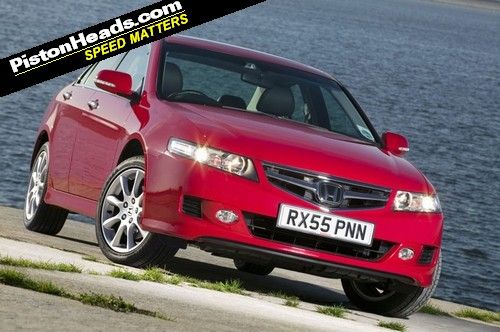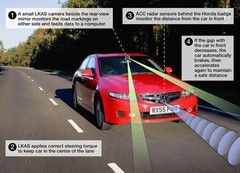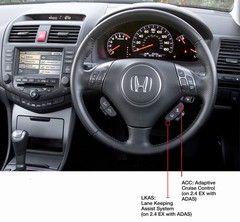Honda ADAS
John Lambert tries Honda's Advanced Driver Assist System. Do you really lose control?

Honda Accord with ADAS
What annoys you about other drivers’ behaviour on the motorway? Tailgating, panic braking, failing to signal, drifting out of lane and failing to keep left must be somewhere near the top of the list.
If more people had Honda Accords with Honda’s Advanced Driver Assist System (ADAS) then the first of four of those five might be greatly reduced. If it could remind a driver to keep left, then it would practically cure motorway bad manners. ADAS consists of two complementary systems, Lane Keep Assistance System (LKAS) and Adaptive Cruise Control (ACC); designed to help drivers with motorway driving.
Stay in lane
Of the two it is LKAS that is more interesting and, according to Honda, the Accord is the first car on sale in Europe with such a system. A sensor at the top of the windscreen looks down for the white lines on the road and, if the road speed is greater than 40mph, the system will start monitoring the car’s position relative to the white lines. A dashboard display indicates whether the system can see the lines.
If the driver tries to cross the lines without first indicating then a warning beep will sound. This of course is nothing new, as some Citroëns will warn you by vibrating the seat but Honda goes further: it'll gently try and steer you back into your lane. LKAS will even steer the car around gentle motorway bends on its own. If you try to drive hands off for more than 20 seconds, however, the car will give a warning beep. If no input is detected the system will shut down as a reminder that the driver must remain in charge.
According to Honda, LKAS is even more effective at night when the contrast between the white lines and the road is greater. Heavy rain can confuse the system, especially if the wipers are on full speed as the wiper blade passes over the sensor. But if LKAS cannot get a fix on the lines you are no worse off than if you were driving a car without the system.
Keep your distance
Adaptive Cruise Control -- systems that over-ride the pre-set cruise control speed -- have been seen before, notably on Mercedes-Benz cars. On an empty road it will maintain the speed set by the driver; should the system detect a slower vehicle ahead it will gradually reduce the cruise control speed to match the car being followed. When the road clears, the cruise control accelerates the car back to the pre-set speed.
Honda's ACC has three, driver-selectable distance settings. If you get too close to the vehicle in front -- the system remains subservient to the driver at all times -- the system beeps to remind you that you should be braking. You will also be warned if the system detects that the car in front is slowing more quickly than the ACC can reduce the car’s speed -- but you should notice this anyway!
On the road
The only way to determine whether the systems work in practice was to get out on the motorway and try them out. Instincts suggested that these were more unnecessary safety systems which removed a degree of control from the driver. I was certain that I would not like LKAS as anything that interfered with the steering had to be a bad idea.
Driving out onto the M62 on a bright Saturday morning, LKAS picked up the white lines without problem. Although it will beep at you if you try and steer over the white line, the amount of resistance it applies to the steering is never sufficient to overpower the driver. If you had to swerve to avoid an obstacle in your lane it would not stop you. That it beeps to remind you to indicate should serve as a handy reminder.
Of course the party piece of LKAS is that it can keep the car in lane while the driver takes his hands off the wheel. It is spooky to sit there watching the car gently steering itself -- drivers of a certain age might remember KITT -- just remember that LKAS won’t steer the car indefinitely.
In practice, if you hold the steering wheel lightly it becomes practically impossible to tell whether you or the car are steering and keeping the car on course; it feels natural rather than artificial. When you leave the motorway you should turn off the system -- there is a button on the steering wheel to do this -- but even if you don’t, you can drive normally.
Adaptive Cruise Control is more impressive because it is easier to see it at work. Set the cruise at your desired speed and as you approach a vehicle in your lane a car-shaped icon on the dashboard illuminates. If their speed is lower than yours the cruise control seamlessly slows you down until your speed matches theirs. If you pull round them (remembering to indicate to avoid being beeped at by LKAS) the cruise control will take you back up to your preset speed if the road is clear.
It makes motorway driving much more relaxing – rather than watching the speedometer you can concentrate on the road ahead and on your mirrors. You can see how, if it was more widely adopted, ACC would reduce instances of tailgating; it might even reduce those annoying instances where traffic brakes to a standstill for no obvious reason.
No excuses
All this technology is no excuse for driving if you are too tired or otherwise unfit to do so. Honda is keen to stress that these systems do not allow the car to drive itself; the ADAS package is simply there to assist the driver. It does nothing that the driver would not do anyway but, if your concentration lapses for a moment, the system is there as an extra pair of eyes and hands.
It is easy to be sceptical, even horrified about what Honda has done but, only when you try it, do you realise the benefits that could accrue if it were more widely adopted.
Links
Gassing Station | Motoring News | Top of Page | What's New | My Stuff






